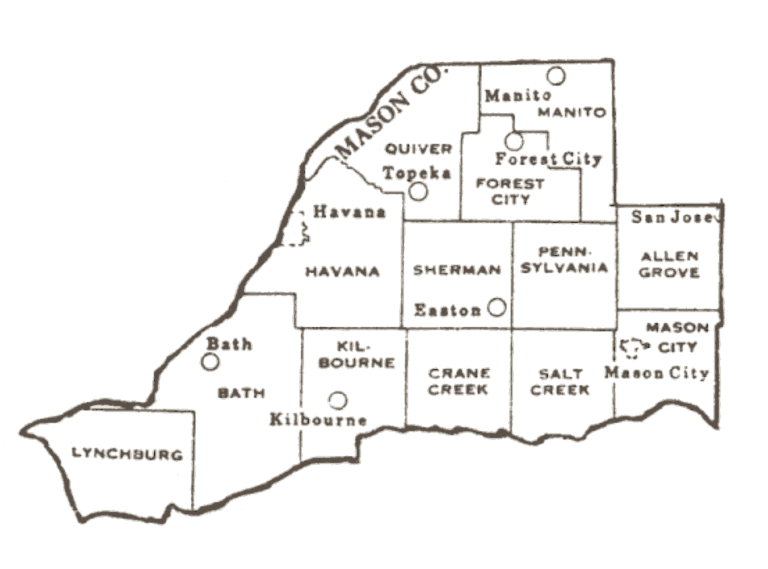Early Mason County History- Pennsylvania Township
Two townships have been complete and this week (Monday through Thursday) I will feature the history of Pennsylvania Township. Enjoy!
Pennsylvania Township
On the 27th of October, 1682, there arrived upon the coast of Delaware Bay, a man whose life and character have been handed down from generation to generation as worthy of emulation and imitation. He was noted not only for the purity and rectitude of his life, but also for his integrity of purpose toward his own countrymen, as well as toward the uncouth and barbarous savage, whose happy hunting-grounds he came to reclaim from their native wildness, and transform into a great and growing province. He came as the proprietor of a vast landed estate, and soon had the satisfaction of gathering around him a large colony that was peaceful, prosperous and happy, almost beyond example. He was at once governor, magistrate, preacher, teacher and laborer. The early prosperity and rapid development of the Quaker State was largely owing to the pacific principles adopted in the beginning, and firmly adhered to by its founder and father, William Penn. To the descendants of its early settlers, the section of Mason County of which we are about to write is indebted for its earliest citizens. Pennsylvania Township is designated as Town 21 north, Range 6 west of the Third Principal Meridian, and is bounded on the north by Forest City and Manito Townships; east, south and west, respectively, by Allen’s Grove, Salt Creek and Sherman Townships. It contains thirty-six full sections, and is one of the two townships of Mason County that exactly coincide with the Congressional survey. Throughout its entire extent it is prairie land. The southern half of the township is rather elevated, while the northern half is low and level. A county ditch crosses the northern portion, through which much of the surface-water of the adjacent bnd finds an outlet. The C., H. & W. R. R. crosses the southwestern corner of the township, its extent from point of entrance to exit being about four miles. Teheran, a station on the road, is located on Section 32, and is the only village in the township.
FIRST SETTLEMENT. While permanent settlements did not begin to be made, prior to the year 1849, in this township, still, as early as the fall of 1844, one adventurous spirit was found within its limits. Ambrose Edwards, from Kentucky, made a squatter’s improvement in what was Red Oak Grove, at the date above mentioned. He was the first to erect his log cabin and begin the cultivation of the soil. The grove in which he located was near the center of the township, but has long since faded from view. It was of small extent, perhaps one mile in length by one-half in width, and was consumed by the earliest settlers while most of it was held by pre-emption right by non-resident parties. Francis Dorrell, who had been a resident of the State since 1835, came from Sangamon County and settled on Section 31, in 1849. His was doubtless the second improvement in HISTORY OF MASON COUNTY. 681 the township. His widow is still a resident. When he settled, not a human habitation was visible on the north, east or west. Stretching away in the dis- tance, visions were sometimes caught, at sunset, of the village of Delavan, twenty-five miles away. Near the same date, William Briggs settled a short distance from where the village of Teheran now stands, but whence he came or whither he went, no one at present living there is able to say. Peter Speice, from Ohio, came early in 1850, and located on Section 20, and was shortly afterward followed by George Sweigert, his father-in-law, who settled in the same locality. They both made improvements, and, after a few years’ residence, sold out and moved to Mackinaw in Tazewell County. A year or two later, quite an influx of population was added to the citizenship of this section from the Keystone State. The settlement became so large in a few years, and the additions made were so uniformly from the same section of country, to the exclusion of almost all others, that it early acquired the distinction of Pennsylvania Settlement, a name yet in use to designate a certain portion of the township. In the fall of 1848, Henry Cease, from Luzerne County, Penn., came and stopped a short time in Havana. He soon purchased a farm and engaged in agricultural pursuits. During the spring and summer of 1851, Joseph and Abraham Cease, Jimison H. Wandel, John W. Pugh and Benedict Hadsall all came in from the same section of country. The Ceases were men of family, while Wandel, Pugh and Hadsall were single men. All were in what is now Havana Township a short time.
In December, 1851, Henry Cease, J. H. Wandel and Abraham Cease went east across Crane Marsh to explore the country, and, on reaching Section 22, in what is now Pennsylvania Township, determined to locate and begin the making of their farms. They each entered a quarter- section and pre-empted the same amount. During the summer of 1852, Abraham and Joseph Cease each built a frame house and began opening up their farms. In April of the same year, Pugh, with whom the climate did not seem to agree, and who had disabled himself by hard work, prevailed upon Wandel to accompany him back to his former home. Wandel, whose favorable impressions of the great and growing West had led him to write back such glowing accounts of the country to his kinsmen, found, to his utter astonishment, upon the day of his arrival, a sale in progress at his father’s and uncle’s, both of whom, with their families, were on the eve of starting for Mason County. After a short sojourn among his native hills, in company with James Wandel, his father, Isaac Honeywell, a brother-in-law, George Wandel, an uncle, and their families, he again turned his face westward. The entire journey was made by water, and the time consumed in coming from Pittsburgh to Havana was seven weeks. With bright hopes and eager expectations of what their future Western homes would soon be, these families had severed the ties that bound them to their native land, to battle with the thousand difficulties incident to pioneer life. But alas for human expectations, the shadow of a great grief accompanied them on their journey.
The decease of Mrs. Honeywell, who had sickened on the way, occurred on the very night of their landing at Havana. Heart-broken and discouraged, with the care of five small children upon his hands, Isaac Huneywell, with J. H. Wandel as a companion, retraced the course so lately passed over. For a time, at least, it seemed that Wandel was destined to belong only to the floating population of the county. During his stay in Pennsylvania, he prepared himself more fully for citizenship in Illinois by taking as a helpmeet Sarah E. Depue, and, in the fall of 1852, with his father-in-law, Aaron Depue, and family, he again came to Mason County. In the summer of 1853, he erected his house and improved forty acres of his farm. He remained a citizen of the township until a few years ago, when he became a citizen of Mason City, in which he at present resides. The others mentioned all settled in the eastern portion of the county, though not all in Pennsylvania Township. Phillip Cease came to the county in 1852, and settled south of Wandel on Section 22. George Wandel purchased an improved farm on which he settled near where the village of Teheran now stands. This, doubtless, was the farm owned and occupied by William Briggs, whose early settlement has already been noted. James Wandel entered and improved a farm on Section 27. James Depue and his family, consisting of George, Henry, James, Jr., Moses, Isaac and one daughter, Mary, settled just across the line, in what is now Salt Creek Township.

